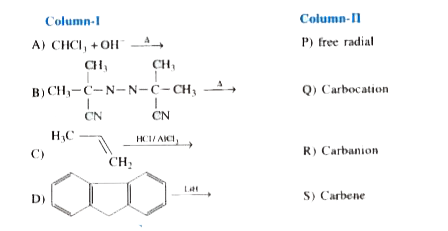Heterolytic fission of a covalent bond leads to the formation of charged speciesSolution in Telugu
Step by step video & image solution for Heterolytic fission of a covalent bond leads to the formation of charged species by Chemistry experts to help you in doubts & scoring excellent marks in Class 11 exams.
Updated on:21/07/2023Topper's Solved these Questions
- GENERAL ORGANIC CHEMISTRYBOOK - AAKASH SERIESCHAPTER - GENERAL ORGANIC CHEMISTRYEXERCISE - Objective Exercise -1
204 Videos
- GENERAL ORGANIC CHEMISTRYBOOK - AAKASH SERIESCHAPTER - GENERAL ORGANIC CHEMISTRYEXERCISE - Objective Exercise -2
82 Videos
- GENERAL ORGANIC CHEMISTRYBOOK - AAKASH SERIESCHAPTER - GENERAL ORGANIC CHEMISTRYEXERCISE - Subjective Exercise -7
8 Videos
- ENVIRONMENTAL CHEMISTRYBOOK - AAKASH SERIESCHAPTER - ENVIRONMENTAL CHEMISTRYEXERCISE - EXERCISE ON PASSAGE (PASSAGE-III)
5 Videos
- HYDROCARBONSBOOK - AAKASH SERIESCHAPTER - HYDROCARBONSEXERCISE - ADDITIONAL PRACTICE SHEET ( LEVEL-II (PRACTICE SHEET (ADVANCED) (MATRIX MATCHING TYPE QUESTIONS)))
5 Videos
Similar Questions
Urea was prepared first time in the laboratory by heating
View SolutionThe compound containing sp sp2 and sp3 hybridised carbon atoms in 1:2:3 ratio is
View SolutionExplain (a) column chromatography, (b) thin layer chromatography and (c ) partition chromatography
View SolutionOzone layer acts as one of the most important life support system. The major cause of ozone layer destruction is believed to be the release of chlorofluorocarbon compounds. UV radiation causes the chlorofluouocarbons to dissociate : CF2Clhv−−→Cl⋅+CF2CI A highly reactive chlorine atomis responsible for the decomposition of ozone. Cl⋅+O3(g)→ClO⋅+O2(g)ClO⋅+O(g)→Cl⋅+O2(g) Free radicals of chlorine decompose ozone molecules in a chain reaction. The depletion of ozone layer leading to ozone hole has, however, been mainly observed in the stratosphere over Antarctica. Special type of cloud called polar stratospheric colouds are formed over Antarctica.These clouds (contain solid HNO3.3H2O) play an important role in ozone depletion.
ClO⋅+NO2→ClONO2
ClONO2+H2O→HOCl+HNO3
ClONO2+HCl→Cl2+HNO3
HOClhv−−→HO⋅+Cl⋅
The reactive chlorine atoms thus formed are rendered to deplete ozone layer.
The ozone layer is present in :
View SolutionMatch the intermediates formed in the reaction.

View SolutionHeterolytic fission of a covalent bond in organic molecules gives
View SolutionCovalent bond undergo fission in two different ways. The correct representation involving a heterolytic fission of CH3−Br is
View Solution(A) Heterolytic fission involves the breaking of a covalent bond in such a way that both the electrons of the shared pair are carried away by one of tha atoms.
(R) Heterolytic fission occurs readily in polar covalent bonds.
View SolutionCovalent bond can undergo fission in two different ways. The correct represenation involving a heterolytic fission of CH3−Br is
View SolutionHeterolytic fission of C - Br bond results in the formation of
View SolutionHomolytic fission of covalent bond leads to the formation of
View SolutionThe homoltic fission of a covalent bond requires _______ energy than that required by its heterolytic fission.
View SolutionHomolytic fission of covalent bond leads to the formation of
View SolutionHomolytic fission of covalent bond leads to the formation of .............
View SolutionHeterolytic fission of C-C bond results in the formation of ...........
View Solution
